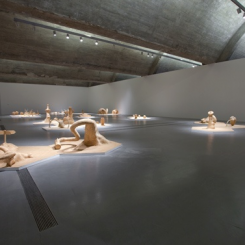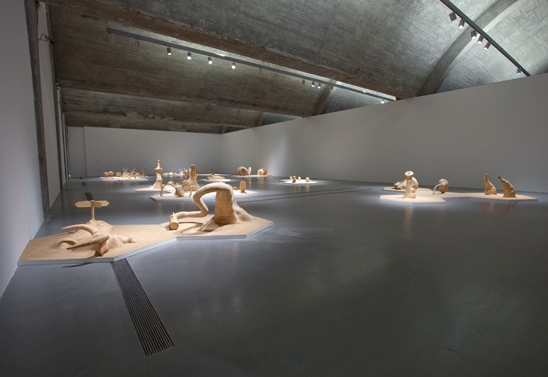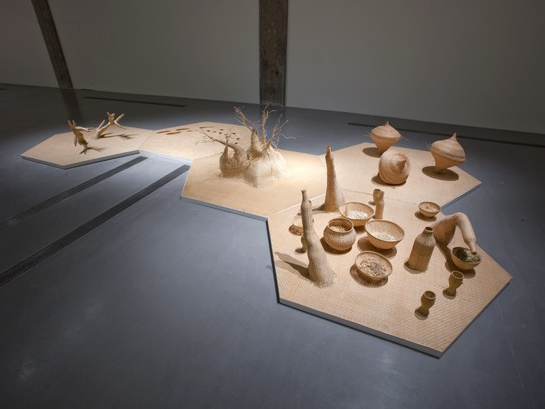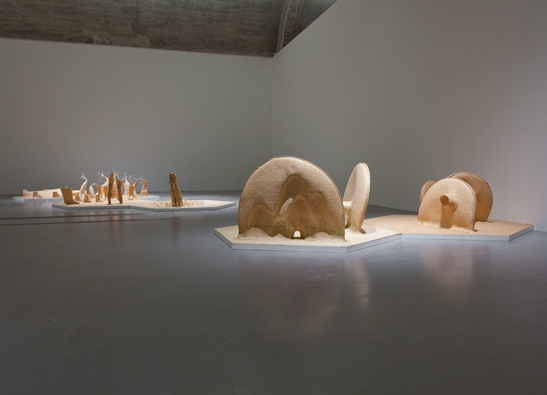Sasha Zhao: Bamboo items appeared in your exhibition “Breaking through the Ice” at the Ullens Center for Contemporary Art in 2009, in which bamboo objects of different forms appeared to grow out from bamboo mats. How is this current exhibition, which again utilizes bamboo as a material, related to the previous project? Bamboo strongly implies Chinese cultural imagery, as with the “Seven Sages of the Bamboo Grove” in the Wei and Jin dynasties or the understanding of the “unity of knowledge and practice” that Wang Yangming achieved through investigating bamboo in the Ming period. What triggered you to return to this “investigation of bamboo” with your literati sensibility? Is this a continuation of the cultural archaeology and imagination of “Qiu’s Notes”?
Qiu Zhijie: Bamboo is indeed a significant element in Chinese culture, but in the process of using it for my work I did not intend to emphasize it as a particularly Chinese cultural element. Of course, my use of bamboo items, beginning with “Interface” and “My 72 Transformations,” has involved a certain recollection of childhood. Bamboo objects evoke memories connected to the recently passed agrarian age. In our present living environment—increasingly virtual and textual—such highly textural materials represent a lifestyle that is almost abandoned. In memory, however, this lifestyle involves a warm and pliable strength. Humanity is losing itself in a torrent of motivational self-improvement and futurism, while there is hidden in the bamboo forest another kind of philosophy.
In this sense I do not stress the blood relationship between bamboo and Chinese culture; in fact, other cultures also have profound knowledges of bamboo. The refinement of Japanese bamboo craft, for example, remains high even today, while a number of other countries take bamboo as an environmentally friendly building material for sustainable development—a kind of bamboo reinforcement to replace steel—and have seen great success. We cannot remain overly immersed in our own stories. Actually, artisanal bamboo weaving in the Chinese tradition is currently leaving the stage of history. Such craftsmen working with bamboo strips are now difficult to find under 40 years old in many places.
The fact that bamboo appears in this work is not directly related to the tradition of the “Seven Sages of the Bamboo Grove,” which assumes bamboo as a metaphorical representation of culture and character. But it is related to the story of Wang Yangming investigating bamboo. While weaving with the bamboo strips I reconsidered the nature of modeling.
The entire production tends toward the confirmation of “principle,” not in terms of “theory” or “rationality” but rather what the Chinese call “sense” or “reason.” Just as bamboo has joints and veins that constitute the principle along which the hands can work, giving rise to both the image and the art of the phrase “as easy as splitting bamboo,” so should other things grow outward according to their inner principles.
SZ: This exhibition is titled “Cell”; what are you trying to reveal through this diction? The cell is the basic unit of the activity of life, and the material of bamboo itself is a product of nature. If the project involves a form of human labor in which the hand participates, how does the work weave this together with the natural growth and propagation of the material?
QZJ: “Cell” refers to the way in which each work in the exhibition space constitutes an individual cell distinct from any other, while they also together constitute an organism. At the same time, it also emphasizes a sensation of spreading or multiplying, just as each of the works here is formed through slow handiwork.
- SZ: How does this exhibition use the Pace Beijing exhibition space? Could you briefly describe how the concept of your work is manifested on site?
QZJ: The on-site manifestation of the work was determined early on: several dozen bamboo mats woven into modeled objects are installed on hexagonal bases. Only the floor of the gallery is used, with the walls left completely empty. The bases are low, so it seems that the objects have grown directly out of the floor. Each bamboo mat work can exist independently, or they can enter into all kinds of relationships in a beehive formation. This will be determined randomly while setting up the exhibition.
SZ: Works like the “Nanjing Yangtze River Bridge” and “Colorful Lanterns of the Shangyuan Festival” have manifested a literati understanding of time and space, involving also the experience and pursuit of extreme feelings like birth and death, sickness and aging, sorrow and joy, parting and reunion. Is this a central thread in the genealogy of your work? Do you find any contradiction between the core of the Chinese literati spirit and the creative methods of contemporary art?
QZJ: Yes, we might say that the “sighing” approach to life found in the Chinese literati’s approach to time and space—which we see in sayings like “[life is as passing as] the footprints of birds in the sand,” “as ephemeral as a fleeting cloud,” and “our descendants will one day look back at us as we today view our ancestors”—constitutes a core thread of my practice.
“The Nanjing Yangtze River Bridge Project” was primarily intended to deal with the value system that says “even common people cannot be deprived of their will,” and to reflect upon the monumentality of large-scale construction projects. Great revolutions always kidnap the fate of the common people with ideals, whether this grand ideal is called “revolution” or, as we find today, “success.” Traditional Chinese thinking has a profound ability to face the void in terms of its approach to power, and a profound sense of empathy and appreciation toward the defeated. Ambition and supremacy, no matter how great, ultimately end up as objects of commemoration. Common people, like bamboo, bend and bow in the face of a strong wind, but do not break; when the wind passes, they stand straight again.
“Qiu’s Notes Project: Colorful Lanterns of the Shangyuan Festival” moves in a similar direction by exploring the latent texts of the theater of the history of sketching, seeking certain genetic traits. The basic structure of such historical stories is acted out again and again in various different eras, including our present age.
As such, my interpretation of Chinese culture emerges from contemporary questions, and the use of contemporary modes of production in terms of form is also necessary in a certain way—there is no contradiction here. The problem is that the methods of contemporary art remain too simple, not subtle enough, and have produced a contemporary audience that brusquely and blindly worships fashion.
SZ: You also have a blog called “Extraordinary Site,” which has maintained a steady rate of updates for many years; the diary seems to be a habit of yours, a method of documenting what happens in the here and now. Has this kind of diary also become a form of inscription, bearing with it your longstanding sigh for “the footprints of birds in the sand”?
QZJ: The “Extraordinary Site” blog was started in late 2005 and has run through the present. It has been viewed almost three million times and currently has 200 visits a day. It has become a medium, and its content is often reposted by other websites, so I cannot really take it as a diary for my own use. What I write there is usually block text, though I sometimes also use it as an educational platform.
Outside the blog, I still insist on writing a diary. When I was young I read the diary of Zeng Guofan and felt markedly inferior, knowing that man could live more seriously and more responsibly. Even if one simply records a few trivial things every day, this too is a time for self-contemplation. Though in these diaries outside of my blog, I do not record everything. To a certain degree, I see my diary as a letter to my future self.
This is not to say that all everyday incidents are worthy of inscription or engraving, but every single day is worth seriously reviewing. Besides the loneliness of “the footprints of birds in the sand,” we also have a concept of cyclical thinking: grief and joy are intermingled, after desperation comes hope, and after liberation there is responsibility. In the story of “The Old Man Who Moves Mountains,” the logic that “I shall leave a son behind, and through him a grandson” marks an instance of such cyclical or staged thinking, just as Liang Qichao said that “Success does not depend on me.” As I grow older I occasionally think that the masters of the past live on in my person. And of course, some tasks that currently lie with me will ultimately be passed down to the next generation to complete. The recording of a diary is related in some way to this awareness.




